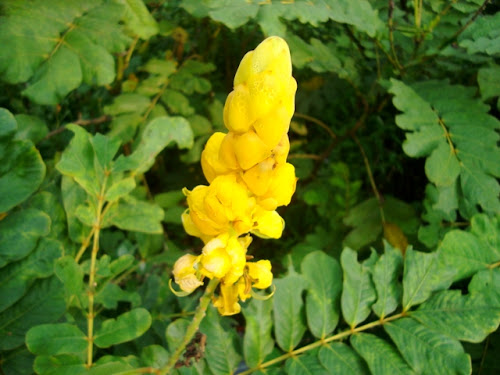Names and uses medicinal property of Christmas candle or Seven golden candlesticks
Emperor's
candlesticks or Empress Candle Plant
is also known in English as Christmas senna, Popcorn senna, Christmas candle,
Seven golden candlesticks, Candlestick senna, Candle bush, Candle cassia,
Candelabra bush, Ringworm bush, Ringworm senna, Wild senna, Winged Senna,
Golden candelabra, Roman Candle tree, Stick senna, Yellow top weed or simply Candle tree. It is called Hinglaj, Dadmurdan, Vilayatiagati and Dadu Ka
Pattain Hindi, Dadmari, Dadumardan in Bengali, Seemaiagathi, Anjali, Vandugolli in Tamil, Mettatamara, Simayavisa in Telugu, Aanattakara, Malamtakara, Puzhukkadittakara, Seema agatti in
Malayalam and Doddachagache in
Kannada. It is called Dadrughna,
dwipagasti in Sanskrit. In Oriya we call it Jadumari (Jadu means
scabbies and mari means killer).
 |
| Senna alata or Cassia alata |
Its Botanical name is Senna alata or Cassia alata.
This plant is native to the Tropics, including Africa, Southeast
Asia, the Pacific Islands, and South America. Its natural distribution is
exceptionally extensive. It is widely distributed in the tropical countries. In
many countries it is often considered as a weed. But it is an important medicinal tree apart from being an
ornamental plant.
 |
| Simayavisa |
It is a perennial shrub with ornate
yellow flowers which blooms through most of the year. The shrub grows up to 3–4
m tall, with leaves 50–80 cm long. The flower looks like a yellow candle. It
begins blooming in October and it has a long blooming season, from autumn
almost throughout the winter. The fruit shaped like a straight pod is up to 25
cm long. The seed pods are dark brown or nearly black, about 15 cm long and 15
mm wide. Pods contain 50 to 60 flattened, triangular seeds. It is grown as an
ornamental plant for its pretty yellow flowers. Cassia alata is easy to
grow from seed. It is a fast grower and flowers in the first year. The plant is
suspected of being poisonous to livestock.
 |
| seeds of Candelabra bush |
Cassia alata or Senna alata has anti-helminthic, antibacterial, laxative, diuretic, Antifungal, Analgesic, alterative,
Antiseptic, Anti-inflammatory, Antibacterial, Hepatoprotective, abortificent,
aperient, purgative, Antimicrobial,
diuretic, anti-herpetic, soporific
properties .
Its fungicide
property derives from chrysophanic acid. It is often called the
Ringworm Bush because of this strong and effective fungicidal property, for
treating infections such as athlete's foot and chronic fungal
infection. Crushed leaves and juice extract is used for treatment of scabies,
eczema, insect bites, impetigo, syphilis
sores, psoriasis, shingles, rash and itching. Skin problems are most often
treated by applying leaf sap or by rubbing crushed fresh leaves on the skin.
It is also used for treatment of uterine disorders. The Plant
also cures inflammation, cough, bronchitis, asthma, constipation, hemorrhoids,
alopecia and sexual debility. In Ayurveda the plant is used as a cure for poisonous bites.
In veterinary medicine too, a variety
of skin problems in livestock is treated with leaf decoctions.
N.B. All the above is solely for informational purpose and NOT INTENDED TO PROVIDE ANY KIND OF MEDICAL ADVICE. A REGD. AYURVEDIC/MEDICAL PRACTITIONER SHOULD ALWAYS BE CONSULTED FOR IT.
 |
| Candelabra bush |
 |
| Hinglaj |